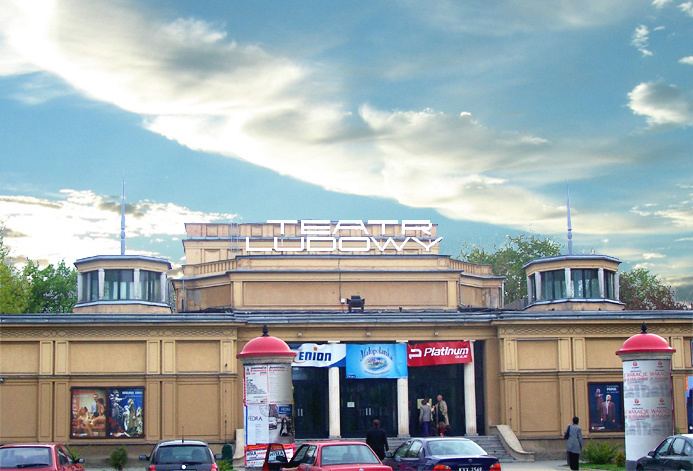Opened 3 December 1955 | Phone +48 12 680 21 12 | |
 | ||
Similar Bagatela Theatre, Juliusz Słowacki Theatre, Helena Modrzejewska National, Łaźnia Nowa Theatre, Kraków Opera Profiles | ||
The Ludowy Theatre (literally: People's Theatre, Polish: Teatr Ludowy) in Kraków, located at Osiedle Teatralne in District Nowa Huta, opened on December 3, 1955, at a time when the official policy of Socialist realism came to an end, and the 1956 de-stalinization of People's Republic of Poland was about to begin. The Ludowy quickly became known as the city's prime avant-garde stage thanks to collaboration of eminent artists such as theatre theoretician and painter Józef Szajna, Tadeusz Kantor (both, from Academy of Fine Arts), Lidia Zamkow, Krystyna Zachwatowicz and others.
Contents
History
Teatr Ludowy, designed by architects Edmund Dąbrowski and Janusz Ingarden, was built in 1954–1955, with the cubic volume of 14,000 m³, seating 420. It was placed in the centre of a socialist housing estate mainly for ideological reasons (as possible vehicle for workers' indoctrination). However, thanks to revolutionary vision of its first president, Krystyna Skuszanka, Teatr Ludowy became one of the most interesting theatres in the country, with Jerzy Krasowski as its first resident director, and painter Jozef Szajna, as its visionary set designer. Together, they turned the young local venue into an innovative and politically engaging stage with serious intellectual and artistic ambitions. Józef Szajna, a survivor of Auschwitz and Buchenwald, became the Theatre artistic director in 1963-1966. In his popular productions of Shakespeare and Greek tragedies, he evoked his own camp experiences; called a theater of death by Peter Brook.
The name, "Ludowy Theatre", had a unique tradition in Kraków in spite of its ostensibly pro-Soviet connotations. In 1902 (during Partitions of Poland), another Ludowy Theatre was opened in Kraków by renown actor Stefan Jaracz, who performed there. It was situated at Krowoderska Street.
Repertoire
For many decades, under communism, Polish theatre employed the artistic technique of political allusion and metaphor in order to overcome censorship. Theatre was not created from the text alone, but from what often remained unspoken and only visually significant. Plays by Aeschylus, Carlo Gozzi and Carlo Goldoni were staged. Skuszanka prepared successful Shakespeare productions: Measure for Measure with stage design by Tadeusz Kantor (1956), The Tempest (1959), and the Twelfth Night (1961) with set design by Józef Szajna. She staged Polish Romantic drama, such as Juliusz Słowacki's Balladyna (1956) and Sen srebrny Salomei (Silver Dream of Salome, 1959). In 1962 Skuszanka and Krasowski prepared a production of Adam Mickiewicz's Dziady with stage design by Jozef Szajna.
The realities of life under communism inspired broader philosophical and ideological questions. Notable plays of the time included productions by Jerzy Krasowski, such as adaptation of John Steinbeck's novel Of Mice and Men (1956) with Franciszek Pieczka (as Lenny Small) and Witold Pyrkosz (as George Milton). There was Franz Werfel's Jacobowsky and the Colonel staged in 1957; as well as Jerzy Broszkiewicz's Imiona władzy (Given Names of Power) directed by Skuszanka (1957), about the issues of freedom. Albert Camus's The State of Siege, was staged jointly with Krystyna Skuszanka in 1958. The novel by Juliusz Kaden-Bandrowski, Radość z odzyskanego śmietnika (Joy of the Repossessed Dumpsite) premiered in 1960.
As the political climate began to worsen, the theatre was faced with increasing criticism. The directors were accused of ignoring uneducated audience. Skuszanka and Krasowski left the Ludowy in 1963, unable to carry on with their ambitious repertoire. Jozef Szajna, who remained, was often sharply criticized. His productions included: Nikolai Gogol's The Inspector General (1963), Tadeusz Holuj's Puste pole (The Empty Field, 1965), Witold Wandurski's Śmierć na gruszy (Death on a Pear-tree, 1965), and Franz Kafka's The Castle with memorable roles by Irena Jun and Jozef Wieczorek (1966). The party guided audiences stopped coming. Szajna left in 1966. In the 1970s the Theatre remained unable to find a formula to satisfy the communist apparatchiks and the critics. Comedies were staged. Consecutive directors tried to revive the tradition of Polish national and folk theatre. The true rebirth came with the collapse of the Soviet empire. In Democratic Poland the Theatre was taken over by an actor, director, and politician Jerzy Fedorowicz (1989–2005). Under his management, the theatre won considerable recognition, and numerous awards. It was twice invited to the Edinburgh International Festival: in 1996 with Macbeth directed by Jerzy Stuhr, and in 1997 with Antigona directed by Włodzimierz Nurkowski. Current director is Jacek Strama, an award winning theatre and film producer.
